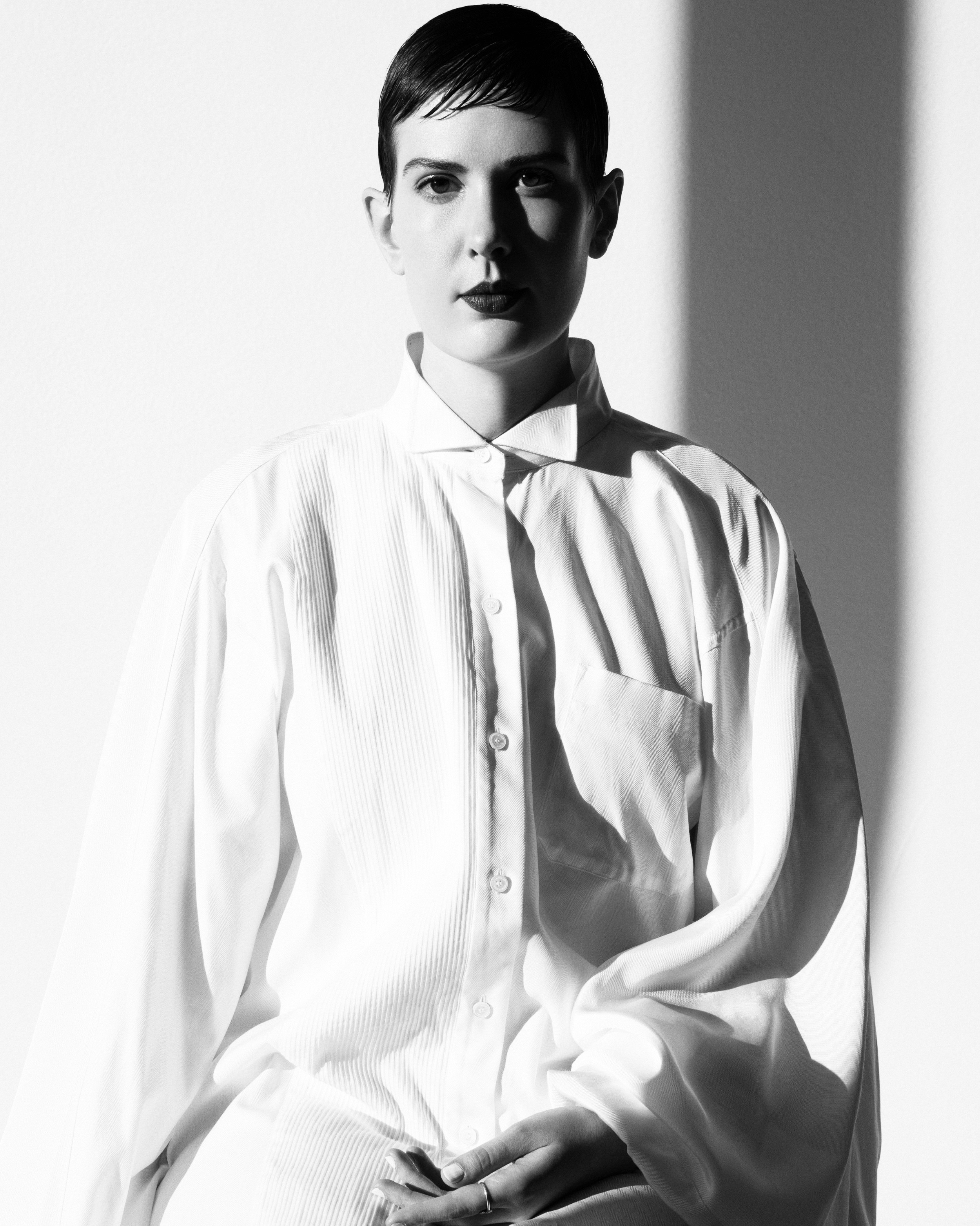“Rape Joke” by Patricia Lockwood
The Second Wave changed the discussion and legal view of rape significantly. However, antirape activists have yet to win the war. The rape epidemic continues, so poetry is once again used to confront it, as exemplified by Patricia Lockwood’s “Rape Joke.” Teenagers, however, are beginning to employ this classic method of evoking empathy to combat sexual violence through poetry with a twist. Hence, the genesis of Pain Memes.

Painting of Patricia Lockwood
Patricia Lockwood’s “Rape Joke” is a modern poem about a rape incident, that addresses the same issues about rape as presented in Adrienne Rich’s “Rape,” Sylvia Plath’s “The Jailor” and June Jordan’s “Case in Point,” for even though the Second Wave changed the legal landscape, rape itself has not changed. A similar element Rich’s “Rape” poem is “the rape joke said you were the one who was drunk, and the rape joke said you remembered wrong, which made you laugh out loud for one split-open second” (Lockwood 5). Lockwood utilizes anaphora, repeating “the rape joke said you“ to emphasize the rape joke’s shifting of the blame. Such is the case Rich makes in the question “will you swallow, will you deny them, will you lie your way home” (Rich, line 30). The woman knows the truth even if the whole world forces them to lie. Rape has not changed. Lockwood’s “Rape Joke” connects to as well to Plath’s “The Jailor” in the line “the rape joke is he wants almost murdered a dude by throwing him through a plate glass window” (Lockwood 2). “Murdered” is a strong, grotesque word. “Dude” is a layman’s term that belittles the event. This demonstration of violent, raw power cast aside through casual wording was a crucial element in “the Jailor” as well, for in both poems the rape victim futilely wishes to their situations were less grim. Rape has not changed. The “Rape Joke” and “The Jailor” end similarly as well. Lockwood wrote on the last page of the “Rape Joke” “So, you did dream of killing the rape joke for years, spilling all of its blood out, and telling it that way. The rape joke cries out for the right to be told” (Lockwood 6). The girl in the “Rape Joke” dreams “of killing the rape joke” just as the captive wife in “The Jailor,” wishes her husband “dead or away” (Plath, line 38). Both women fantasize about killing their demon but neither one can. Rape has not changed. The “Rape Joke” shares an element of Jordan’s “Case in Point” too in the line “the rape joke is that he was your boyfriend” (Lockwood 1). The reader stumbles upon the devastating realization that the man who raped the narrator of the “rape joke” was a man who she had trusted: her “boyfriend.” A betrayal like this happens to the narrator of “Case in Point” for her perpetrator was the “head of the local NAACP”
 (Jordan, lines 14). Rape is always a form of betrayal. Rape has not changed. Like in “Case in Point” the “Rape Joke” tells the story of the silence that falls upon the raped woman in the line “the mattress felt a specific way, and your mouth felt a specific way opened against it, as if you were speaking, but you know you were not. As if your mouth were open 10 years into the future, reciting a poem called Rape Joke” (Lockwood 4). The narrator repeats “felt a specific way,” as she replays that moment in her mind. She relives the experience so acutely that she can find no other words to accurately
(Jordan, lines 14). Rape is always a form of betrayal. Rape has not changed. Like in “Case in Point” the “Rape Joke” tells the story of the silence that falls upon the raped woman in the line “the mattress felt a specific way, and your mouth felt a specific way opened against it, as if you were speaking, but you know you were not. As if your mouth were open 10 years into the future, reciting a poem called Rape Joke” (Lockwood 4). The narrator repeats “felt a specific way,” as she replays that moment in her mind. She relives the experience so acutely that she can find no other words to accurately
describe it, yet she describes the silence perfectly. The victim’s silence in that moment gave her a voice in the future. That is the silence Jordan states is “peculiar to the female” (Jordan, lines 26-7) in her poem “Case in Point.” The silence when a girl is raped and her silence that follows her rape is what halts the outcry against the crime committed against her. One thing has changed. Through Pain Memes, these girls are starting to find their voice.
Teenagers on YouTube, both young girls and young boys, are beginning to use Richard Dawkins’s “Meme Theory” as their modern vessel to carry their uproar against the rape epidemic. Meme Theory is Richard Dawkins’ principle that certain ideas have the ability to spread though cultures like wildfire if the presentation of the idea and the idea is ideal for such the conditions of the time. Teenagers have found the ideal “meme” for transmitting their stories about rape: Pain Memes. According to Kaitlynn Mendes, the author of “Digitized Narratives of Rape: Disclosing Sexual Violence Through Pain Memes,” Pain Memes are “a means of storytelling in which a script is written as a short passage, conveying painful personal experiences through the visceral means of hand-crafted signs.” This multimedia storytelling device is as elegant as it is simple. In each video, words, written in informal text, appear on a screen either digitally or on flashcards. Music plays and no words are spoken as the words appear and disappear. Using this platform, rape victims make their stories known to their audience both conceptually and emotionally. The personal touch of different forts and languages, the alluring ambient music, the silent victim behind the screen all draw in the viewer and allow them to connect on a deeper level with the story they read. No longer are rape victim’s words begin monitored by the patriarchy. They can share their experiences without being immediately judged to their face. The Pain Memes have proved to be a personal form of healing for those still suffering from the trauma. YouTube gives them the feeling that they are being heard, and many of them are. Millions upon millions of people have access to and actually watch YouTube. And rape victims have the access to share their story with them all. As Kaitlynn Mendes writes in her examination of the modern outcry against sexual violence, “finally, although it is unlikely that everyone who shares their experience of rape considers this to be an activist, or even a feminist, act, making oppression visible has always been a key tenet of feminism” (Mendes). There is still hope.
Sources:
Jordan, Mark A. “What’s In A Meme?” Richard Dawkins Foundation for Reason and Science, Center for Inquiry, 4 Feb. 2014, https://www.richarddawkins.net/2014/02/whats-in-ameme/.
Mendes, Kaitlynn, et al. “Digitised Narratives of Rape: Disclosing Sexual Violence Through Pain Memes.” SpringerLink, 24 March, 2019, https://link.springer.com/chapter/10.1007/978-3-030-13852-3_8.
“My Rape Story (Part 1).” https://www.youtube.com/watch?v=Oafsfy0NYXA.
“My Rape Story.”, https://www.youtube.com/watch?v=Oafsfy0NYXA.
“Patricia Lockwood.” Talk Easy with Sam Fragoso, 23 Oct. 2017, http://talkeasypod.com/artist/patricia-lockwood/.
“Real Meaning Behind The Word ‘Meme.’” Science Insider, https://www.youtube.com/watch?v=6iHZi-z7H4o.
Staff, Harriet. “Patricia Lockwood ‘Rape Joke’ Poem Is World-Famous by Harriet Staff.” Poetry
Foundation, Poetry Foundation, https://www.poetryfoundation.org/harriet/2013/07/
The Awl. “Patricia Lockwood, ‘Rape Joke.’” The Awl, https://www.theawl.com/2013/07/patricia-lockwood-rape-joke/.
Tsakona, Villy, and Jan Chovanec. The Dynamics of Interactional Humor: Creating and Negotiating Humor in Everyday Encounters. John Benjamins Publishing Company, 2018, https://books.google.com/books?id=qZFDwAAQBAJ&pg=PA263&lpg=PA263&dq=why are some lines humorous and others not&source=bl&ots=kgAqQO9Ht-&sig=ACfU3U21jDM6v4Ivya4mwyQdU23mb_kCmQ&hl=en&sa=X&ved=2ahUKEwii4JGx4ajmAhVKwlkKHcWgDccQ6AEwCXoECAoQAQ#v=onepage&q=why are some lines humorous and others not&f=false.
